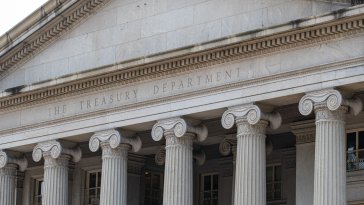
US reaction: Powell speech – getting into a hole?
- 23 August 2024 (3 min read)
KEY POINTS
Fed Chair Powell delivered his keynote speech at the Fed’s Jackson Hole symposium. After a period of relatively quiet economic data and in the wake of robust market moves, markets was focused on what direction the Fed Chair would set in the countdown to an FOMC meeting where the Fed is expected to start an easing cycle.
Fed Chair Powell did not disappoint. He confirmed that his confidence had grown that inflation was back on a sustainable path to target. He also stated that the labour market had cooled considerably, albeit from formerly overheated levels, but that the Fed did not “seek nor welcome” any further cooling in the labour market. Finally he concluded that while economic activity remained solid, both the inflation and labour market were in an “evolving situation”. Powell stated that the “time has come for policy to adjust”. He went on to qualify that the “timing and pace” of future adjustment would be down to the data, the evolving outlook and the balance of risks. But he concluded that in dialing back policy restriction to see inflation fall to 2% and maintain a strong labour market, the Fed had “ample room” to respond “including to the risk of an unwelcome further easing in the labour market”.
Since the surprise inflation burst of Q1, we have considered September the most likely time for the Fed to start easing. The question has been one of pace. While Powell did not tie himself to any outlook today – that will be more evident in September’s rate projections, which in June saw the median FOMC participant only anticipate one cut this year – we suggest that Powell leant into expectations of a fast easing. His description of “ample” space to respond to the “risk” of an unwelcome labour market easing suggests a Fed that could front-load easing. This was in striking contrast to the more considered comments from Boston Fed’s Collins and Philadelphia Fed’s Harker who both described “gradual” and “moderate” in their expectation of the outlook for future policy. Powell mentioned neither, something that is likely to be seen as endorsing current pricing. We are reminded of last December’s Fed press conference, when Powell had been expected Powell to check aggressive market expectations of rate cuts for 2024. In the event, he did not, instead fanning further expectations, which resulted in a sharp reversal early this year. Indeed, Powell made no reference to financial conditions today, which were already as loose as they have been since mid-2022 and back around pre-pandemic levels even before his speech. These have loosened further now.
We are more cautious in our outlook. We have expected an exaggerated softening in the labour market over the summer, but forward-looking data suggest a stabilization over the months ahead; economic expansion remains solid (Atlanta now tracker for Q3 at 2.0%); and we expect a soft landing. As such, we have been expecting the Fed to ease at a gradual pace over the coming years and are mindful that the election of former President Trump could result in a new round of supply shocks that could restrict the Fed’s freedom to ease. We forecast two rate cuts this year (September and December), but see a clear risk that the Fed front loads back-to-back cuts to include a November cut. Next year’s outlook would be election dependent, but if Trump were re-elected we think the Fed may only be able to cut twice next year. We do not see the market view of a 50bp cut at one of this year’s meetings as likely. Nor do we expect 200bps of easing by this time next year.
Rate markets were reasonably guarded in their reaction on the back of Powell’s speech. The chance of a 50bps cut in September rose by nearly 10ppt to 25%. The chance of 100bps of easing this year rose by 30ppt to be fully-priced. 2-year US Treasury yields dropped 8bps to 3.93% and 10-year yields 5bps to 3.80%. The dollar however, dropped by 0.7% against a basket of currencies (including to $1.118 to the euro) and global stocks rose, including the S&P 500 index, which was up 0.4% on the speech.
Disclaimer
This website is published by AXA Investment Managers Australia Ltd (ABN 47 107 346 841 AFSL 273320) (“AXA IM Australia”) and is intended only for professional investors, sophisticated investors and wholesale clients as defined in the Corporations Act 2001 (Cth).
This publication is for informational purposes only and does not constitute investment research or financial analysis relating to transactions in financial instruments, nor does it constitute on the part of AXA Investment Managers or its affiliated companies an offer to buy or sell any investments, products or services, and should not be considered as solicitation or investment, legal or tax advice, a recommendation for an investment strategy or a personalized recommendation to buy or sell securities.
Market commentary on the website has been prepared for general informational purposes by the authors, who are part of AXA Investment Managers. This market commentary reflects the views of the authors, and statements in it may differ from the views of others in AXA Investment Managers.
Due to its simplification, this publication is partial and opinions, estimates and forecasts herein are subjective and subject to change without notice. There is no guarantee forecasts made will come to pass. Data, figures, declarations, analysis, predictions and other information in this publication is provided based on our state of knowledge at the time of creation of this publication. Whilst every care is taken, no representation or warranty (including liability towards third parties), express or implied, is made as to the accuracy, reliability or completeness of the information contained herein. Reliance upon information in this material is at the sole discretion of the recipient. This material does not contain sufficient information to support an investment decision.
All investment involves risk , including the loss of capital. The value of investments and the income from them can fluctuate and investors may not get back the amount originally invested.


